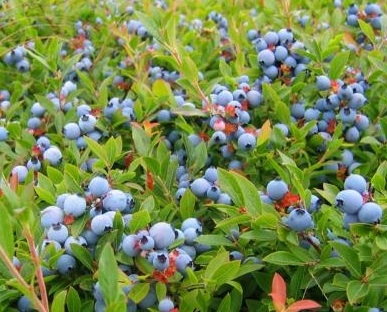
Features
Production
Research
Optimizing fertilizer rates for wild blueberry
November 29, 2016 By American Society for Horticultural Science

November 29, 2016, Kemptown, NS – The authors of a study in HortScience (September 2106) say that wild blueberry nutrient management varies considerably compared with typical tilled crop systems.
According to the study, there is a “tremendous amount of uncertainty” in wild blueberry nutrient management as a result of dynamic interactions among plant and soil factors. To increase understanding of fertilizers’ impact on wild blueberry, scientists in Nova Scotia carried out a 12-year field experiment that produced valuable recommendations for optimum rates of fertilizers to enhance growers’ profitability.
Corresponding author Rizwan Maqbool explained that the study was designed to determine the main and interactive effects of soil-applied nitrogen-phosphorous-potassium (N-P-K) fertilizers on wild blueberry growth, development, and berry yield, and then to recommend fertilizer rates that optimize these outcomes. The scientists employed a three-factor central composite design with treatment combinations of five levels of fertilizer N (0, 12, 30, 48, and 60 kg·ha-1), P (0, 18, 45, 78, and 90 kg·ha-1), and K (0, 12, 30, 48, and 60 kg·ha-1). The wild blueberry plants treated were evaluated in a 12-year (six production cycles) field experiment at Kemptown, NS.
Results showed that an optimal value of 17.8 cm for stem length was obtained with fertilizer rates of 50 kg·ha-1 N, 48 kg·ha-1 P, and 30 kg·ha-1 K. The maximum number of vegetative nodes per stem occurred at fertilizer rates of 49 kg·ha-1 N, 48 kg·ha-1 P, and 65 kg·ha-1 K, while the maximum number of floral nodes per stem were found with fertilizer rates of 34 kg·ha-1 N, 45 kg·ha-1 P, and 30 kg·ha-1 K.
The optimal number of berries per stem (11.9) was obtained at N, P, and K rates of 40, 38, and 33 kg·ha-1, respectively. Rates of N-P-K fertilizer calculated for optimal berry yield were 30 kg·ha-1, 45 kg·ha-1, and 32 kg·ha-1, respectively.
“Based on the results of this study, we recommend applying 35 kg·ha-1 N, 40 kg·ha-1 P, and 30 kg·ha-1 K at the onset of shoot emergence each sprout year in lowbush blueberry in central Nova Scotia,” the authors wrote. “These rates optimized floral bud number, berries per stem, and berry yield, without resulting in excessive stem growth and should be tested in other lowbush growing regions such as Maine, New Brunswick, Ontario, and Quebec.”
Analyses showed that the higher fertilizers rates cost an extra $80/ha but increased net profits by $490/ha.
“Findings of this study could contribute toward better farm profitability in areas with similar growing conditions,” the authors noted.
The study also suggests that modifications to existing fertilizer rates be made for wild blueberries growing in central Nova Scotia.
The complete study and abstract are available on the ASHS HortScience electronic journal web site: http://hortsci.ashspublications.org/content/51/9/1092.abstract
Print this page